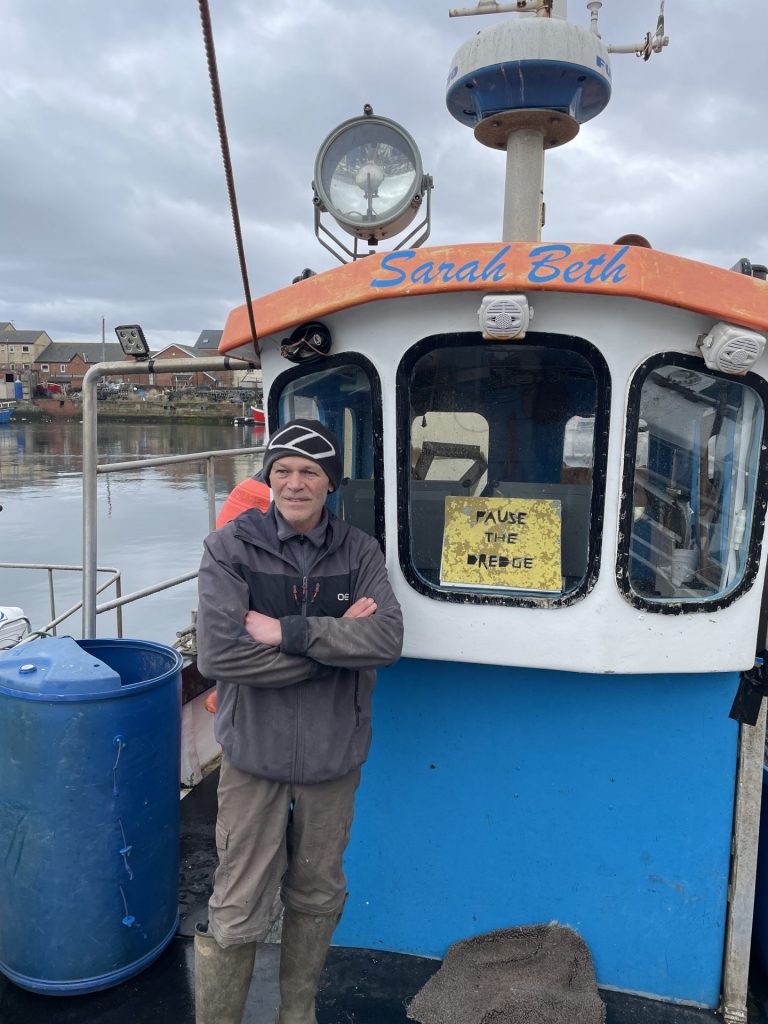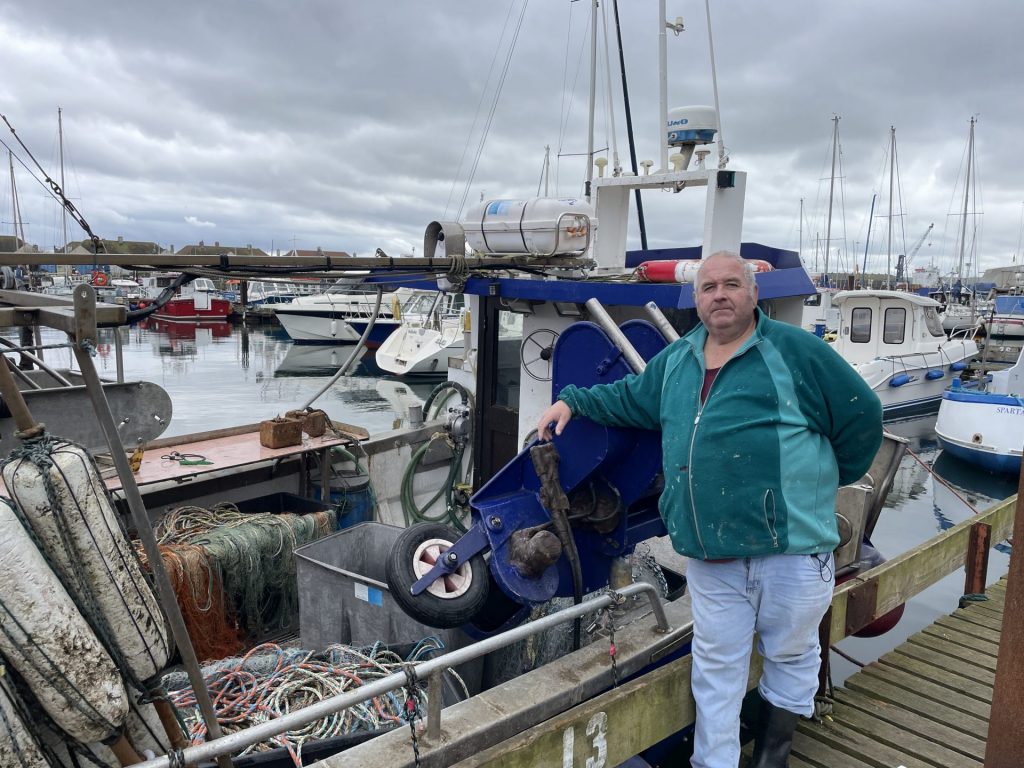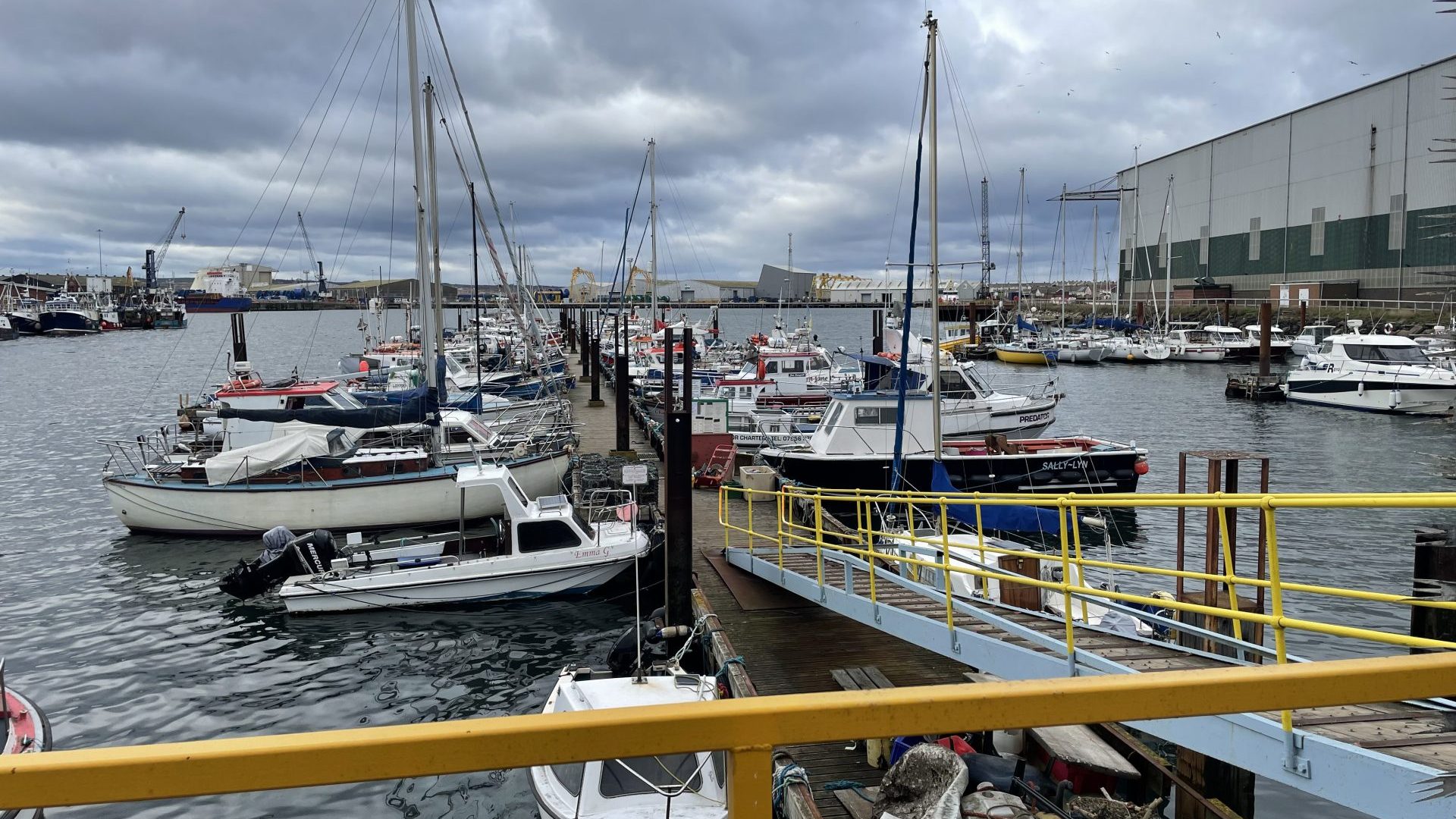On the edge of The Headland, just outside Hartlepool, County Durham, it is a cold and blustery day. In the distance is Bran Sands, a jut of land perched at the face of the estuary where the river meets the North Sea, and a dredger is passing by, moving tonnes of sediment from the River Tees to be disposed of some miles out. Fishermen Paul Widdowfield and Stan Rennie tell me this sight has become a daily occurrence. To them, it is a salty and unwelcome one.
Neither Widdowfield nor Rennie have gone out on their day boats for almost 18 months now. Both had fished out of Hartlepool for 40 years or more, catching brown and velvet crabs and highly prized lobsters. Today, in an area synonymous with fine shellfish, there is little or nothing left to land. Crustaceans, they say, have all but “disappeared” after works began to build the controversial Teesside Freeport.
The development is intended to create a giant manufacturing hub that can then take advantage of tariff-free status. Freeports are part of Boris Johnson’s post-Brexit ‘levelling up’ legacy, although there are huge doubts about whether they are effective. Critics say that rather than bringing in new investment, freeports simply move economic activity from one place to another, and the Office for Budgetary Responsibility (OBR) is predicting that as a result, lost tax will cost the UK government £50m a year.
Teesside has proved particularly controversial over claims that £100m of land earmarked for the project has been sold to two developers for just £96.79. Parliament’s business and trade committee has launched an inquiry into “reported issues” with the freeport, but Tees Valley’s Tory mayor Ben Houchen continues to insist that the deal will create over 2,000 jobs, return £40m to the public purse and bring in £7m a year in local rates.
Yet the national attention means little to Widdowfield and Rennie, whose focus understandably remains on their lost trade.

“The inside shellfish grounds have been completely decimated,” Widdowfield tells The New European. “There are no crabs, and there’s a light sprinkling of lobsters, but not enough to warrant going out. Especially not with fuel prices the way there are. We’d lose money.
“For years, shellfish caught along the North East Coast have been deemed among the best in the world. We’ve been supplying restaurants for decades, and have exported to Europe and China and made a good living. Everybody has always wanted what we catch, and now there’s nothing.
“Our ecosystem has been completely destroyed. And nobody in power seems to care. What’s left here is a toxic wasteland. Everything is dead. That’s business, I suppose. And maybe there are benefits to a lot of people. But there aren’t any to us, and I don’t think there are to the environment.”
The Teesside Freeport is, according to the government, the UK’s largest, “driving growth in renewables, advanced manufacturing and the chemicals and process sectors.”
The site covers 4,500 acres, taking in docklands in Hartlepool, Middlesbrough and Redcar. Quays across the Tees Valley are still being built, while infrastructure that went before it, broken up and dismantled. The landscape is changing.
Widdowfield and Rennie, along with dozens of other fishers along the coast in the North East, are less enamoured by the prospect of continued building works. The dredging, carried out to allow for larger boats to come in and out, is ongoing, lifting more sediment inshore before “dumping it” farther out to sea.
To really understand what’s happening to the fishing industry in Teesside, one has to journey back to the autumn of 2021, when the first widespread crustacean deaths were recorded. Then, thousands of crabs, as well as other marine life, washed up on the shorelines along the North East and on coastlines in Yorkshire. Nobody knew why.
In November last year, an investigation by a panel of experts began, after the government, through a Defra report, had said previously that a naturally-occurring algal bloom was the most likely cause.
It was a case of conflicting evidence. Fishermen, in turn, believe a chemical called pyridine, prevalent in several industries on Teesside in years gone by, most notably steel, is to blame, and which tests showed was “exceptionally toxic” to crabs. They believe the chemical may have been dumped in the river and then disturbed, or released from the mud after focused explosions were used to remove past infrastructure.
Fisheries minister Mark Spencer said at the time that the panel would consider “all explanations” for the deaths. “I recognise fishing communities in the North East want as thorough an assessment as possible into the crab and lobster deaths last year,” he said.
“Defra’s investigation concluded that the most likely cause was an algal bloom, but we have always recognised this is a complex area of science and have remained open to further research.
“That’s why it is right that all the evidence is now assessed by independent experts and I look forward to receiving their advice.”
The Conservative MP for Scarborough and Whitby, meanwhile, Sir Robert Goodwill, who chairs the Environment, Food and Rural Affairs Committee, told BBC Radio Tees at the time that “we need to get on with it,” as “people do need answers” and “it’s important we get to the bottom of this”.
Skip forward to January this year, and subsequent reports emerged that suggested the mass death of crabs and lobsters, apocalyptic and harrowing as they were, “may have been caused by a disease previously unknown to science”. The notion that an algae bloom might have been behind the deaths was done away with. Other supposed causes? Harmful chemicals disturbed in the riverbed following decades of heavy industry? “Inconclusive”.
The report said: “It is about as likely as not that a pathogen new to UK waters – a potential disease or parasite – caused the unusual crab mortality.
“There are pathogens known to cause similar symptoms to those observed in the north-east and these pathogens have caused mortality events and declines in crustacean populations around the world.”
Crucially, Defra’s chief scientist Gideon Henderson, with input from the government’s then chief scientific advisor, Sir Patrick Vallance, concluded that it was, following analyses by the Environment Agency and York University, “unlikely” that “pyridine or another toxic pollutant caused the crab deaths.”
Widdowfield and Rennie have numerous choice words for these results. Through their newly formed North East Fishing Collective, of which Rennie is chair, they plan to “fight” for their fishery, which, whatever the cause, looks destined to be forever eroded.
“I’ve been fishing here since I was 13, since 1974,” Rennie says. “Back then, there were crabs and lobsters everywhere. You could make a decent living. All of a sudden, they disappear. The habitat seems to have been decimated, destroyed.

“There’s always a need for maintenance – small dredging has always happened here – but to bring in bigger dredgers and to dredge constantly, every day, I think is having a devastating impact. I think it’s shameful, really. It’s upsetting. I thought sustainability was important?
“I think reports have been misleading. There is clearly pollution here and now it’s being spread around, it’s starting to spread up the coast, and down as far as Whitby. I think there are toxins contaminating our rivers and seas, and these issues need to be addressed.”
In Hartlepool and beyond, the dispute has been fierce. On one side are those lauding a flagship Tory economic policy; on the other, locals who have seen their incomes dry up, with little by way of a meaningful answer.
A key response to calls from fishers for greater certainty has come from the South Tees Development Corporation, which said dredging did not begin until September 2022, nearly a year after the first reported crustacean deaths.
“The first dredging being carried out in respect of the South Tees Development Corporation (also known as Teesworks) is capital dredging to enable the development of a new £107 million South Bank Heavy Lift Quay,” the corporation told The New European.
“This dredging began on 1 September 2022, 11 months after the first reported die-off of crustaceans.”
But fishers and environmentalists say it was original works – namely, the destruction of the steelworks on the banks of the Tees – that first released pollutants into the Tees. All that dredging is doing, they argue, is “stirring it up and spreading it around”, escalating a problem that might have been prevented.
The North East Fishing Collective has commissioned its own studies of the Tees, hoping to more strongly identify pollutants that it believes are to blame. Rennie and Widdowfield also believe works have been expedited, pointing the finger at the South Tees Development Corporation. The authority told The New European that this was untrue.
In a statement, it added: “The first marine deaths occurred 11 months before any work was carried out and no further issues have been reported by Defra or the Marina Management Organisation in relation to the work carried out so far.
“Indeed, the recent independent expert assessment of crustacean mortality compiled by a panel of independent experts, convened by Defra’s chief scientific advisor, states that there is a less than one per cent probability that dredging was the cause of these deaths.
“Our transformative work at the South Bank Quay is of national significance and will help to unlock thousands of jobs.”
Gary Caldwell, a senior lecturer in applied marine biology at Newcastle University, has been continuing to test and collect samples from the river, estuary, and sea, and will soon release new results. He says he believes the marine life deaths are linked to the development work on Teesside.
“We do think the deaths are linked to the release of pollution to the Tees as part of the development work taking place there. I think it’s tied into the freeport. We’re trying to trace it back.
“It’s detective work. There’s pollution evident and we’re trying to trace it back to the source. Everything points towards a pollution source.
“Fisheries everywhere are suffering from contamination to some degree. But here in the North East, the decline seems to be precipitous. It’s like someone’s flicked a switch.”
Caldwell says it is most likely to be a combination of factors that has led to the repudiation of sea life.
“You can’t pin it on dredging alone,” he explains. “But the extent of the excavations on the bank of the river, I think that’s impacted highly contaminated ground and released harmful materials. I believe these are there and have been innocently moved offshore through continued dredging.”
Caldwell, and the fishermen on Teesside, are struggling to see how the coastline might recover, with reports of dwindling catches beginning to spread. There is, says Caldwell, a “creeping spread” of pollution, but to quantify the reach is a time-consuming, near thankless task.
For now, it appears almost impossible to qualify answers. The government is holding firm, with Defra suggesting its figures show total fishing landings on Teesside “increased by six per cent” in January 2023 compared to last year. The North East Fishing Collective says these represent larger boats that fish much farther out to sea, away from the problem areas, and it is the inshore fishermen who are struggling.
Defra told The New European: “We know that bad weather was one of several factors affecting the inshore fleet and the figures have no connection with crustacean mortalities in the North East, which took place before the reporting period. We are backing our fishing communities with £100m to boost growth and opportunities, including for shellfish vessels.”
Additional funding might be all very well… but what use is it when there is nothing to catch?











